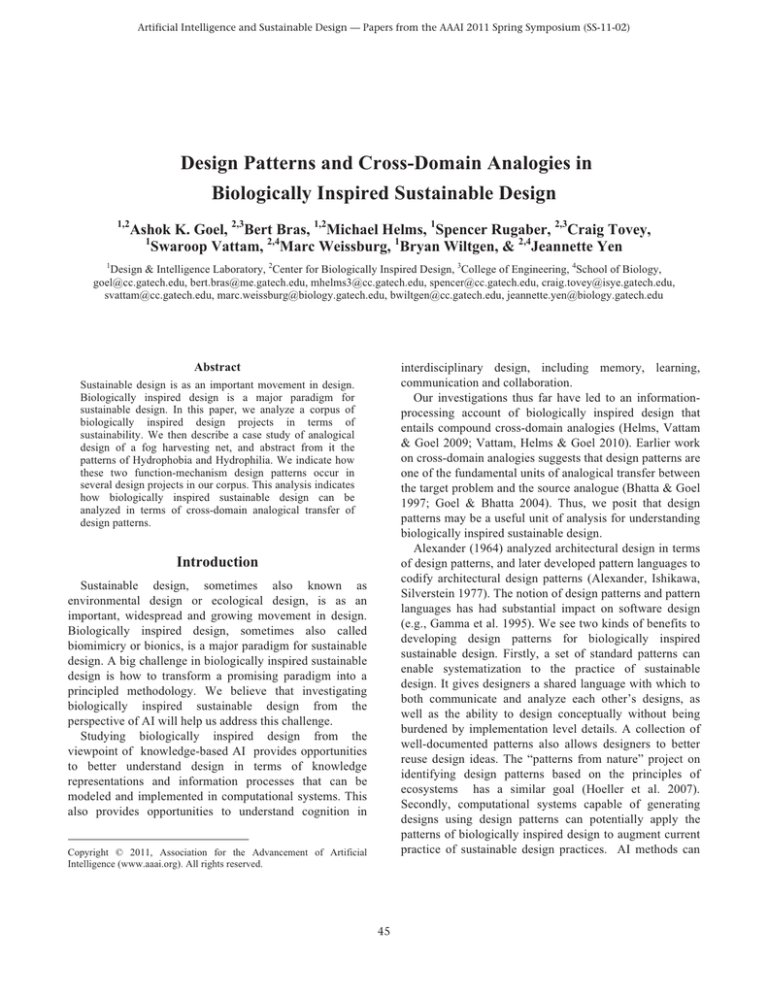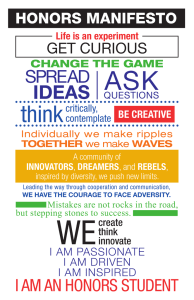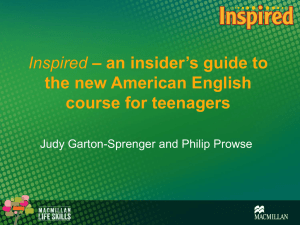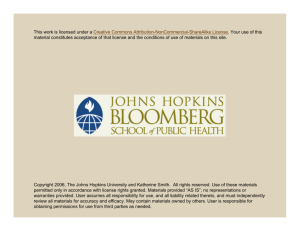
Artificial Intelligence and Sustainable Design — Papers from the AAAI 2011 Spring Symposium (SS-11-02)
Design Patterns and Cross-Domain Analogies in
Biologically Inspired Sustainable Design
1,2
Ashok K. Goel, 2,3Bert Bras, 1,2Michael Helms, 1Spencer Rugaber, 2,3Craig Tovey,
1
Swaroop Vattam, 2,4Marc Weissburg, 1Bryan Wiltgen, & 2,4Jeannette Yen
1
Design & Intelligence Laboratory, 2Center for Biologically Inspired Design, 3College of Engineering, 4School of Biology,
goel@cc.gatech.edu, bert.bras@me.gatech.edu, mhelms3@cc.gatech.edu, spencer@cc.gatech.edu, craig.tovey@isye.gatech.edu,
svattam@cc.gatech.edu, marc.weissburg@biology.gatech.edu, bwiltgen@cc.gatech.edu, jeannette.yen@biology.gatech.edu
interdisciplinary design, including memory, learning,
communication and collaboration.
Our investigations thus far have led to an informationprocessing account of biologically inspired design that
entails compound cross-domain analogies (Helms, Vattam
& Goel 2009; Vattam, Helms & Goel 2010). Earlier work
on cross-domain analogies suggests that design patterns are
one of the fundamental units of analogical transfer between
the target problem and the source analogue (Bhatta & Goel
1997; Goel & Bhatta 2004). Thus, we posit that design
patterns may be a useful unit of analysis for understanding
biologically inspired sustainable design.
Alexander (1964) analyzed architectural design in terms
of design patterns, and later developed pattern languages to
codify architectural design patterns (Alexander, Ishikawa,
Silverstein 1977). The notion of design patterns and pattern
languages has had substantial impact on software design
(e.g., Gamma et al. 1995). We see two kinds of benefits to
developing design patterns for biologically inspired
sustainable design. Firstly, a set of standard patterns can
enable systematization to the practice of sustainable
design. It gives designers a shared language with which to
both communicate and analyze each other’s designs, as
well as the ability to design conceptually without being
burdened by implementation level details. A collection of
well-documented patterns also allows designers to better
reuse design ideas. The “patterns from nature” project on
identifying design patterns based on the principles of
ecosystems has a similar goal (Hoeller et al. 2007).
Secondly, computational systems capable of generating
designs using design patterns can potentially apply the
patterns of biologically inspired design to augment current
practice of sustainable design practices. AI methods can
Abstract
Sustainable design is as an important movement in design.
Biologically inspired design is a major paradigm for
sustainable design. In this paper, we analyze a corpus of
biologically inspired design projects in terms of
sustainability. We then describe a case study of analogical
design of a fog harvesting net, and abstract from it the
patterns of Hydrophobia and Hydrophilia. We indicate how
these two function-mechanism design patterns occur in
several design projects in our corpus. This analysis indicates
how biologically inspired sustainable design can be
analyzed in terms of cross-domain analogical transfer of
design patterns.
Introduction
Sustainable design, sometimes also known as
environmental design or ecological design, is as an
important, widespread and growing movement in design.
Biologically inspired design, sometimes also called
biomimicry or bionics, is a major paradigm for sustainable
design. A big challenge in biologically inspired sustainable
design is how to transform a promising paradigm into a
principled methodology. We believe that investigating
biologically inspired sustainable design from the
perspective of AI will help us address this challenge.
Studying biologically inspired design from the
viewpoint of knowledge-based AI provides opportunities
to better understand design in terms of knowledge
representations and information processes that can be
modeled and implemented in computational systems. This
also provides opportunities to understand cognition in
Copyright © 2011, Association for the Advancement of Artificial
Intelligence (www.aaai.org). All rights reserved.
45
then partner human designers through mixed-initiative
strategies.
A major portion of the rest of this paper is dedicated to
the discussion about design patterns in the context of
sustainable design, and to illustrating how such patterns
can be derived from specific case studies of biologically
inspired sustainable designs.
Another set of efforts describes cognitive studies of
biologically inspired design (e.g., Helms, Vattam & Goel
2009; Linsey, Wood & Markman 2008; Mak & Shu 2008;
Vattam, Helms & Goel 2010). A third set of attempts at
systemizing biologically inspired design describe
knowledge-based interactive systems for capturing,
organizing, accessing, and presenting knowledge of
biological systems (e.g., Chakrabarti et al. 2005, Chiu &
Shu 2007, Nagel et al. 2008, Nagel et al. 2010, Sarkar &
Chakrabarti 2008, Sartori, Pal & Chakrabarti 2010, Shu
2010, Vattam et al. 2010).
In this paper, we adopt a different stance towards
biologically inspired design. Firstly, while most of earlier
work mentioned above has been motivated by the goals of
understanding and supporting innovative design, this work
is driven by the need to understand sustainable design.
Secondly, while earlier work has focused on representing
and accessing designs of specific biological systems, we
posit design patterns as a fundamental unit of analogical
transfer from biological systems to technological problems.
A design pattern is an abstraction of design solutions for
a class of design problems (Alexander, Ishikawa &
Silverstein 1977). A design pattern typically consists of
three parts: a pattern name or label, a design problem, and
an abstract design solution that specifies some arrangement
of relationships among some objects or features to address
the problem. For example, a design pattern in architecture
may capture the spatial arrangement of columns to achieve
a specific structural goal in a particular context. An actual
design may instantiate one or more design patterns, and
thus is a design instance. In this paper, we focus on design
patterns in which the design goal pertains to the
accomplishment of a function and the arrangement of
relationships refers to a causal mechanism for achieving
the function.
The origin of our hypothesis about design patterns being
one of the fundamental unit of analogical transfer lies in
our earlier AI work on we have developed computational
accounts of cross-domain design analogies in conceptual
engineering design (Bhatta & Goel 1997; Goel & Bhatta
2004). In cognitive science, Holyoak & Thagard (1989)
describe a similar information-processing model of
analogies called “Process Induction.” In our work, we
postulated two kinds of design abstractions: Generic
Physical Principles (or GPPs) and Generic Teleological
Mechanisms (or GTMs). GPPs are general domain
principles that capture behaviors such as flow of heat from
a hot body to a cold body. GTMs are function-mechanism
pairs in which a particular abstract causal mechanism
results in the achievement of a particular abstract function,
for example, closed loop feedback (a particular abstract
causal mechanism) results in the achievement of regulating
the output variable of a system (a particular abstract
function). The IDeAL system implemented the GTMs and
Background
Sustainable design refers to the design of products,
materials, processes and services in accordance with the
principles of biological diversity, ecological integrity, and
environmental responsibility (Anastas & Warner 2000;
Birkeland 2002; Ehrenfeld 2008; McDonough & Braungart
1992; Papanek 1984; Van der Ryn & Cowan 1996; Wann
1990). Design for reuse and design for recycling have long
been a part of product lifecycle management (Fiksel 1996;
McDonough & Braungart 1992; Pahl & Beitz 1996), and
their importance likely will increase with time. However,
sustainable design goes much further than design for reuse
or recycling: sustainable design engages a new set of
economic, social, and cultural values such as use of local
resources, water conservation, energy efficiency, and
minimal carbon emissions. By bringing new design
requirements and constraints into the design problem
statement, sustainable design changes the nature of the
design problem itself.
Biologically inspired design espouses the use of
biological analogues to address technological problems
(Bar-Cohen 2006, Benyus 1997; Collins & Brebbia 2004;
French 1998; Bonser & Vincent 2007; Vincent & Mann
2002; Vogel 2000; Yen & Weissburg 2007). While
biologically inspired design strongly aligns itself with
sustainable design, it is also understood that not all
biologically inspired design leads to sustainable design
(Reap, Baumeister & Bras 2005; Vincent et al. 2006).
Compared to technological designs, biological designs
typically are robust, efficient, multifunctional, and
adaptable. Further, while human technology tends to use
energy to address many design problems, biological
systems often rely on information for the same functions
(Vincent et al. 2006). Biological designs also tend to use a
limited set of locally available materials, avoiding scarce,
toxic, or exotic materials. The Biomimicry Institute’s web
portal called AskNature (http://www.asknature.org/) and
Georgia Tech’s Center for Biologically Inspired Design
(CBID) (http://www.cbid.gatech.edu/) provide many
examples of biologically inspired sustainable design.
Recently there have been several attempts at systemizing
biologically inspired design as a general methodology for
innovative design. Vincent et al. 2006, for example,
describe BioTRIZ, an effort to apply TRIZ’s (Altshuller
1984) inventive principles to biologically inspired design.
46
GPPs in a computer program. It is in the sense of the GTM,
where an abstract function (or class of problems) is related
to an abstract causal mechanism, that we use the term
“pattern” in this paper.
An open issue is if such generic function-mechanism
patterns occur in biologically inspired sustainable design.
If similar design patterns do occur in biologically inspired
sustainable designs, then we wonder whether existing
computational theories of cross-domain design analogies
based on design patterns provide a useful starting point for
developing computational accounts of analogical transfer
in biologically inspired sustainable design
The ME/ISyE/MSE/PTFe/BIOL 4740 class is both a
teaching and a research laboratory for us. From 2006
onwards, we have collected data on all student design
projects, and in some cases, recorded details of the design
trajectories. These design projects are the data for our
analysis of biologically inspired sustainable design.
Initial Data Analysis
In Table 1 we present synopses of each of the final
biologically
inspired
design
projects
in
ME/ISyE/MSE/PTFe/BIOL 4740 since 2006. We
categorize each project as either (a) intentionally
addressing issues of sustainability, (b) incidentally
addressing issues of sustainability, or (c) not sustainability
focused. Our analysis aimed at identifying whether
increasingly sustainability was the primary goal of the
design project. This is in contrast to whether or not a
project included a secondary objective of increasing
characteristics of sustainability. For example, if the goal of
the design is to increase the energy efficiency of solar
thermal heaters, we consider that an “intentionally
sustainable” design. Another intentionally sustainable
design, the WASP Paper project in 2009, designed a paper
production system that conserved water and energy relative
to existing methods. In contrast, a luminescent surfboard
designed to reduce the incidence of shark attacks that was
solar powered, we consider “incidentally sustainable.” This
is because while some design decisions were made to
include features that increased characteristics of
sustainability (“solar powered”), the primary goal
(“preventing shark attacks”) did not pertain to
sustainability per se. As second example of incidentally
sustainable designs, the Antifouling Armor project in 2007
designed a biofilm-resistant catheter to reduce the number
of infections caused by conventional catheters. Despite not
being the primary goal of the project, the improved
catheter had stronger sustainability characteristics because
it was longer-lasting and required less energy to clean than
a conventional design.
In either case, we make no claims as to the net impact of
these designs in terms of sustainability; it is the intent of
increasing sustainability in the design concept that we
considered in our analysis. We recognize that this
definition of sustainability does not address the entire
product lifecycle (i.e., manufacturing and end-of-life).
Since our corpus of designs was at the conceptual level,
we felt that making judgments about manufacturing and
end-of-life sustainability would be premature and errorprone.
Data Sources
Each fall term since 2005 Georgia Tech’s Center for
Biologically Inspired Design has offered a senior-level,
project-based interdisciplinary course in biologically
inspired design (ME/ISyE/MSE/PTFe/BIOL 4740).
Faculty members from Georgia Tech’s Schools of Biology,
Mechanical Engineering, and Industrial & Systems
Engineering teach the course jointly. Many guest lectures
by other biologically inspired design researchers are also
included. The course typically attracts forty to forty five
(mostly) undergraduate students every year. The class
composition too is interdisciplinary: in Fall 2009 the class
was comprised of fifteen biology students, eleven
mechanical engineering students, and fourteen other
students from a variety of academic disciplines, including
biomedical engineering, chemical engineering, industrial
engineering, material science, and mathematics.
The course is structured into lectures, found object
exercises, and a semester-long design project. Most
lectures are focused on exposing student designers to
specific case studies in BID, while found object exercises
require designers to bring in biological samples and to
analyze the solutions employed by these samples. The
semester-long design projects group an interdisciplinary
team of 4-6 students together based on similar interests.
Instructors ensure that each team has at least one designer
with a biology background and a few from different
engineering disciplines. Each team identifies a problem
that can be addressed by a biologically inspired solution,
and develops a design based on one or more biological
design cases. Each team has one or more faculty as
mentors who give expert advice as and when needed. All
teams present their problem and initial design concepts
during the middle of the term, then submit final designs
during the last two weeks of class along with a final design
report. Yen, Helms, Vattam & Goel (2010); Yen,
Weissburg, Helms & Goel (2011); Yen, Weissburg &
Tovey
(2010)
describe
the
pedagogy
in
ME/ISyE/MSE/PTFe/BIOL 4740.
47
Table 1: Corpus of biologically inspired design projects from 2006-2010
48
In reading Table 1, note that darkly shaded designs are
those where sustainability was a primary goal of the
project. Lightly shaded designs are those where the design
appears sustainable but only incidentally so. Designs
whose names begin with an asterisk (*) implemented the
Hydrophobic/hydrophilic design pattern, and designs
whose names begin with a hash (#) were inspired by the
Namibian Beetle.
Looking at the whole corpus of 42 designs, we saw that
26 of the designs appeared sustainable, with 20
intentionally designed to address sustainability and 6
incidentally addressing sustainability. However, this is
perhaps an unreliable statistic, as the 2008 and 2009
semesters were specifically aimed at producing sustainable
designs. Looking only at the projects from 2006, 2007,
and 2010, we see that out of 25 projects, 10 of the designs
addressed sustainability, with 5 intentionally addressing
sustainability and 5 incidentally addressing sustainability.
Thus, even when sustainability was not a class focus, a
sizable portion of the class still produced designs that
showed features of sustainability.
means to afford water piped in from elsewhere and are also
economically limited because of the shortage of water. The
design problem was further complicated by the need for
simplicity of use, ease of maintenance, and low cost.
Detailed Case Study
In this section we provide a case study highlighting a
biologically inspired design produced by a team of students
ME/ISyE/MSE/PTFe/BIOL 4740 in Fall 2008 that showed
strong sustainability characteristics. The goal of the design
is to harvest water in areas that do not have access to
ground water, but which receive fog and dew on a regular
basis. People in these regions typically do not have the
Figure 1. Final design of fog net cylinder.
Figure 2. Graphical representation of function/mechanism/sub-function relationships in the
fog net design.
49
in an arid dessert, several miles inland from a coast. During
certain daily weather patterns, a fog rolls across the
dessert, during which time the beetle positions itself on the
crest of a dune, raises its body into the air, with its head
lower than its rear. The shell of the beetle has the same
arrangement of hydrophilic bumps and hydrophobic
valleys as we described in the net, which performs the
same function of harvesting water from the fog. The water
rolls down the channels of the shell toward the head of the
beetle, where it can be consumed.
Note that the design illustrated in Figure 1 is one of two
independent cases of the Namibian beetle inspiring a fogharvesting device in ME/ISyE/MSE/PTFe/BIOL 4740.
Furthermore,
in
another
design
project
in
ME/ISyE/MSE/PTFe/BIOL 4740, this same Namibian
beetle analogy was also used to inspire water collection
and water flow down a “self-cooling” wall in a building,
which was designed to passively cool a building. Thus the
same function-mechanism pattern used for water
harvesting served a higher-level function, that of cooling.
In another, similar biological system, the lotus leaf uses
a hydrophobic surface to cause water to bead up and roll
down the leaf, taking with it debris particles and
pathogens, maintaining a cleaner, more productive and
healthier leaf. In this case, the mechanism of hydrophobia
directs the behavior of the water towards the function of
passive self-cleaning. We have also seen this functionmechanism pattern used in class in the development of a
catheter that is manufactured with a surface similar to the
lotus leaf. The catheter will, in theory, remain cleaner and
prevent infection more than would a traditional catheter.
We note that the same general patterns appear to occur
in two very biological systems, the Namibian beetle and
the lotus leaf. For this reason, we will call them the
“Hydrophobia” and “Hydrophilia” design patterns, rather
than a “Namibian beetle” pattern or a “lotus leaf” pattern.
The Hydrophobia and Hydrophilia patterns are abstractions
over the designs of the Namibian beetle and the lotus leaf.
Note also there seem to be two design patterns here, not
one. The lotus leaf uses only the Hydrophobia pattern to
achieve one function. The Namibian beetle uses a
combination of the Hydrophobia and Hydrophilia patterns
to accomplish a different function. One can imagine other
combinations of the two patterns, perhaps with other
design patterns, to produce a range of system designs.
In addition, we note that both patterns are a functionmechanism pair (as in GTMs in our earlier work). The
Hydrophobia design pattern for example has the function
to repel water, with an associated mechanism borne out of
structural regularities of a particular type for
accomplishing the function. The Hydrophilia design
pattern has the function of attracting water, with a different
mechanism arising out of a different type of structural
regularities to achieve the function.
The Design
Figure 1 illustrates the final design proposed by the
interdisciplinary design team of biologists and engineers.
As Figure 1 indicates, the design consists of a fog net
cylinder on which fog would condense as is passed through
the net fabric. Net designs in rectangular patterns, hung
between two vertical poles, are already in use (Vince,
2010). The design team proposed that their design
improves on the existing design in three ways. First, the
cylindrical shape means that the water collection is
independent of wind direction, and could be deployed in
areas where wind direction was not always predictable.
Second the netting material itself, instead of being made of
a uniform material, was to be made of a textured material,
consisting of (1) hydrophilic (water-attracting) bumps,
approximately 2mm in diameter, surrounded by (2)
hydrophobic (water-repelling) materials. The hydrophilic
bump provides an initial site for airborne water to gather,
and because of its shape, water can be expected to bead at
the crest of the bump.
When the water bead reaches sufficient mass, gravity
will offset the attractive force between the water and the
surface, and the bead will roll into a hydrophobic valley.
Because of the water repellency of the valley, the bead of
water will continue to roll down the net, where it will
collect in the container below the net. The third
improvement in the proposed design relative to the current
design is in the angle of the mesh of the netting itself. The
mesh in the netting will have more acutely vertical
alignment, orienting the rolling drops downward, more
than outward, increasing the rate at which water droplets
descend the net.
Figure 2 shows a graphical representation of the
function/sub-function relationships in the design, with
harvest water as the primary function, and three subfunctions: collect water, move water, and store water. Each
function is preceded by an input state, and followed by its
output state. Furthermore, in this figure, the causal process
of the collect water function is elaborated, providing a
detailed state-transition diagram annotated with the causal
processes that result in each transition. From this detailed
description, we see that water is brought to the net “by
Wind” and nucleates on the hydrophilic bump as a result of
the principle of “by Hydrophilic Surface”. Such a detailed
causal account of the process used in the final design
provides leverage for indentifying, extracting and
transferring the key patterns in the design.
Biological Analogies and Design Patterns
Based on our interpretation of the artifacts produced in this
design project, the design of the material for the net
apparently was inspired by analogy to one primary
biological system, the Namibian beetle. This beetle lives
50
Conjectures
Acknowledgments
It is much too early in our analysis of biologically inspired
sustainable design in terms of design patterns to draw any
firm conclusions. At this stage, we can only adopt a stance,
posit hypotheses and make conjectures.
Sustainable design is an emerging interdiscipline. As
with any new interdiscipline, there is a need to systemize
the knowledge and processes of sustainable design.
We
believe that AI, especially knowledge-based AI, can be
helpful in this systemization of knowledge, reasoning, and
learning in sustainable design. AI develops content
accounts of knowledge and builds schemes for
representation and organization of knowledge. AI also
builds process accounts of complex tasks and constructs
computational techniques for the use, access, acquisition,
and communication of knowledge in the process accounts.
In this paper, we have tried to use AI as a lens to analyze
a corpus of design projects in biologically inspired
sustainable design. We have posited that design patterns
may be a useful unit of analysis for developing content and
process accounts of biologically inspired sustainable
design. We have also illustrated what such a content
account might look like.
These process and content accounts might potentially
play several roles. From one perspective, such accounts
could be used to support human designers. A process
account could aid in the education of biologically inspired
sustainable designers by providing a template upon which
to develop curricula, and robust knowledge representations
could help designers describe what they know and
integrate new information about biological systems or
patterns from prior successful designs into their own
designs. As we mentioned in our introduction, a good
knowledge representation allows users of that
representation to ignore unnecessary or distracting details
and to focus on those features that are pertinent to the task
at hand. We believe articulating design patterns in the
manner that we have done in this paper is one small step to
achieving this vision.
From another perspective, process and content accounts
could lead to the development of AI agents that enact
biologically inspired sustainable design. Systems already
exist for partially automated analogical design in the
domain of simple engineering systems (Bhatta & Goel
1997; Goel & Bhatta 2004), and we are currently pursuing
the goal of re-implementing such systems for biologically
inspired design. A next logical step would be to include
design patterns that may lead to sustainable design such as
the one identified in this paper, allowing for mixedinitiative generation of biologically inspired sustainable
designs.
This research has been generously supported by the US
National Science Foundation through a CreativeIT grant
(#0855916) entitled “Computational Tools for Enhancing
Creativity in Biologically Inspired Engineering Design.”
References
Alexander, C. (1964) Notes on the Synthesis of Form. Harvard
University Press.
Alexander, C., Ishikawa, S., Silverstein, M. (1977) A Pattern
Language – Towns, Buildings, Construction, Oxford University
Press.
Altshuller, G. (1984). Creativity as an Exact Science: The Theory
of the Solution of Inventive Problems. Translated from Russian by
A. Williams (1988), Gordon & Breach.
Anastas, P. & Warner, J. (2000) Green chemistry: theory and
practice, Oxford University Press.
Bar-Cohen, Y. (editor, 2006) Biomimetics: Biologically inspired
technologies. Taylor & Francis.
Benyus, J. (1997) Biomimicry: Innovation Inspired by Nature.
William Morrow.
Birkeland, J. (2002). Design for Sustainability: A Sourcebook of
Integrated Ecological Solutions. London: Earthscan Publications.
Bhatta, S., & Goel, A. (1997) A Functional Theory of Design
Patterns. In Proc. 15th International Joint Conference on
Artificial Intelligence (IJCAI-97), Nagoya, Japan, August 1997,
pp. 294-300.
Bonser, R., & Vincent, J. (2007) Technology trajectories,
innovation, and the growth of biomimetics. Proceedings of the
Institution of Mechanical Engineers, Part C: Journal of
Mechanical Engineering Science, pp. 1177-1180.
Brebbia, C. (editor, 2010) Design and nature V: comparing
design in nature with science and engineering Wessex Institute of
Technology Press.
Chakrabarti, A., Sarkar, P., Leelavathamma, B., & Nataraju, B.
(2005) A functional representation for aiding biomimetic and
artificial inspiration of new ideas. Artificial Intelligence for
Engineering Design, Analysis and Manufacturing, 19:113-132.
Chiu, I., & Shu, L. (2007) Using Language as Related Stimuli for
Concept Generation. Artificial Intelligence for Engineering
Design, Analysis and Manufacturing, 21/2:103–121.
Ehrenfeld, J. (2008). Sustainability by Design: A Subversive
Strategy for Transforming Our Consumer Culture. Yale
University Press.
Fiksel, J. (editor, 1996). Design For Environment: Creating EcoEfficient Products and Processes. New York: McGraw-Hill, Inc.
French, M. (1998) Invention and evolution: design in nature and
engineering. Cambridge University Press.
Gamma, E., Helm, R., Johnson, R., & Vlissedes, R. (1995)
Design Patterns: Elements of Reusable Object-Oriented
Software, Addison-Wesley.
Goel, A., & Bhatta, S. (2004). Use of Design Patterns in
Analogy-Based Design. Advanced Engineering Informatics,
18(2):85-94, April 2004.
51
Vincent, J. F. V., Bogatyreva, O., Bogatyrev, N., Bowyer, A. &
Pahl, A-K. (2006) Biomimetics: its practice and theory. Journal of
the Royal Society Interface 3, 471-482.
Vincent, J., & Mann, D. (2002) Systematic Transfer from Biology
to Engineering. Philosophical Transactions of the Royal Society
of London, 360: 159-173.
Vogel, S. (2000) Cat’s paws and catapults: mechanical worlds of
nature and people. Norton & Company.
Wann, D. (1990) Biologic: environmental protection by design.
Johnson Books.
Yen, J., Helms, M., Vattam, S., & Goel, A. (2010) Evaluating
biological systems for their potential in engineering design.
Advances in Natural Science 3(2): 27-40.
Yen, J. & Weissburg, M. (2007) Perspectives on biologically
inspired design: introduction to the collected contributions.
Bioinspiration and Biomimetics 2.
Yen, J., Weissburg, M., Helms, M., & Goel, A. (2011)
Biologically Inspired Design: A tool for interdisciplinary
education. To appear in Biomimetics: Nature-Based Innovation,
Y. Bar-Cohen (editor), Taylor & Francis.
Yen, J., Weissburg, M., & Tovey, C. (2010) Enhancing
Innovation Through Biologically Inspired Design. Proc. 3rd
International Conference on Bionics Engineering, Zhuhai, China,
September 2010.
Helms, M., Vattam, S. & Goel, A. (2009). Biologically inspired
design: process and products. Design Studies, 30(5): 606-622.
Hoeller, N., Salustri, F., DeLuca, D., Zari, M.P., Love, M.,
McKeag, T., Stephens, E., Reap, J., Sopchak, J. (2007) Patterns
from Nature. Procs. Society for Experimental Mechanics Annual
Conference and Exposition on Experimental and Applied
Mechanics, 2007.
Holyoak, K., & Thagard, P. (1989) A computational model of
analogical problem solving. In S. Vosniadou & A. Ortony
(editors), Similarity and Analogical Reasoning (Cambridge
University Press), pp. 242-266.
Linsey, J., Wood, K., & Markman, A. (2008). Modality and
representation in analogy. Artificial Intelligence for Engineering,
Design, and Manufacturing, Special issue on multi- modal
design, Goel, Davis and Gero (editors). 22:85-100.
Mak, T., & Shu, L. (2008) Using descriptions of biological
phenomena for idea generation. Research in Engineering Design,
19:1:21-28.
McDonough, W, & Braungart, M. (1992) The Hannover
Principles: Design for Sustainability. New York: W McDonough
Architects.
Nagel, J., Nagel, R., Stone, R., & McAdams, D. (2010) FunctionBased Biologically Inspired Concept Generation. AI for
Engineering Design, Analysis and Manufacturing, 24(4): 521535.
Nagel, R., Midha, P, Tinsley, A, Stone, R., McAdams, D., & Shu,
L. (2008) Exploring the use of functional models in biomimetic
concept design. ASME Journal of Mechanical Design, 130(2).
Pahl, G., & Beitz, W. (1996) Engineering Design: A Systematic
Approach. Berlin: Springer.
Papanek, V (1984) Design for the real world, human ecology and
social change. Pantheon Books.
Reap, J., Baumeister, D., & Bras. B. (2005) Holism, Biomimicry
and Sustainable Engineering. Procs. ASME International
Mechanical
Engineering
Conference
and
Exposition
(IMECE2005).
Sarkar, P., & A. Chakrabarti, 2008. The effect of representation
of triggers on design outcomes. Artificial Intelligence for
Engineering Design and Manufacturing. Special issue on multimodal design, Goel, Davis and Gero (editors). 22(2).
Sartori, J., Pal, U., & Chakrabarti, A. (2010) A Methodology for
Supporting Transfer in Biomimetic Design. AI for Engineering
Design, Analysis and Manufacturing, 24(4): 483-506.
Shu, L. (2010) A Natural Language Approach to Biomimetic
Design. AI for Engineering Design, Analysis and Manufacturing,
24(4): 507-519.
Van der Ryn, S. & Cowan, S. (1996). Ecological Design.
Washington, D.C.: Island Press.
Vattam, S., M. Helms & A. Goel. (2010) A Content Account of
Creative Analogies in Biologically Inspired Design. AI for
Engineering Design, Analysis and Manufacturing, Special Issue
on Biologically Inspired Design, 24: 467-481.
Vattam, S., B. Wiltgen, M. Helms, A. Goel & J. Yen. (2010)
DANE: Fostering Creativity in and through Biologically Inspired
Design. Procs. First International Conference on Design
Creativity, Kobe, Japan, November 2010.
Vince, G. (2010) Out of the Mist. Science, November 2010: 330
(6005): 750-751.
52







